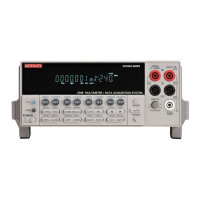6-12 Buffer Model 2700 Multimeter/Switch System User’s Manual
g. TRACe:TSTamp:FORMat ABSolute | DELta Select timestamp format
For front panel operation, both timestamp formats (absolute and delta) can be recalled. For
remote programming, you can only use one timestamp at a time.
NOTE Changing the timestamp format clears the buffer.
The timestamp will only be included with a returned buffer reading if it is specified as a data
element (see FORMat:ELEMents).
h. TRACe:FEED SENSe | CALCulate | NONE Select source of readings
TRACe:FEED:CONTrol NEXT| ALWays | NEVer Select buffer control
TRACe:FEED — The SENSe parameter selects readings before any enabled mX+b, Percent
or Reciprocal math calculation. For the CALCulate parameter, the result of the calculation is
stored in the buffer. The NONE parameter disables storage into the buffer. Math functions
are covered in
Section 5.
NOTE In order to store readings in the buffer, TRACe:FEED cannot be set to NONE.
TRACe:FEED:CONTrol — Selecting NEXT enables the buffer. After the specified number
of readings (buffer size) are stored, buffer operation disables. The ALWays parameter places
the buffer into a continuous filling mode. After the specified number of readings are stored,
operation wraps back to the first buffer location and overwrites the previous readings. The
NEVer parameter disables buffer operation.
i. TRACe:DATA? Read buffer
Use TRACE:DATA? to retrieve all readings that are stored in the buffer. You can send this
command even if the instrument is still storing readings. When TRACe:DATA? is sent, it
will return the readings stored up to that point in time. Subsequent TRACe:DATA?
commands will not retrieve readings already returned. However, once the buffer has filled
and you have retrieved all buffer readings, you can again send TRACe:DATA? to retrieve all
the stored readings.
The data elements returned with each stored reading depends on which ones are selected
with FORMat:ELEMents command (see Section 14 for details).

